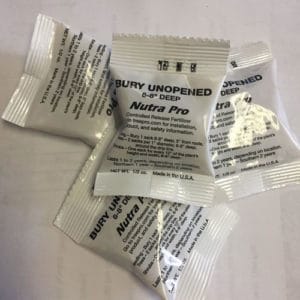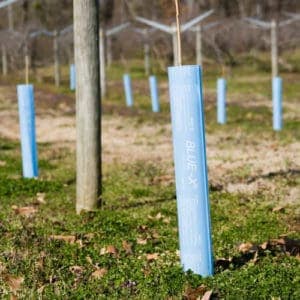Our tree sale is complete for this year. We will be having another tree sale this fall. If you aren’t on the tree sale email list and would like to be, please send an email to Tess at Anastasia.Wallner@usda.gov. Happy planting!
Trees & shrubs sold in previous years:
(Annual selection varies)
American Arborvitae Tree/Shrub
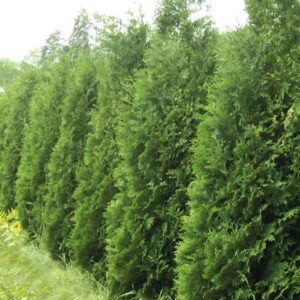
American Plum Tree
Grows as a large shrub or small tree sometimes up to 25-30 feet. Likes moist soils. The shrub is winter-hardy, but has little tolerance for shade, drought, or fire. Produces white flowers in spring and fruits are about 1 inch in diameter. The American plum is used for both ornamental and culinary purposes. The sour and sweet fruit is eaten fresh and is made into jellies, jam and wine.
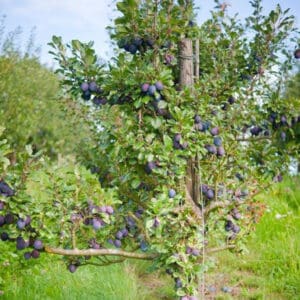
American Plum Tree/Shrub
Basswood Tree
American basswood is native to the Chicago area and is often used as a specimen or dense shade tree. Its heart-shaped leaves and fragrant flowers in June make it especially attractive for people, while songbirds and blue jays are attracted to its seeds and use the tree for shelter.
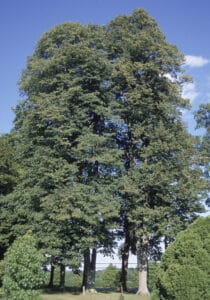
Black Cherry Tree
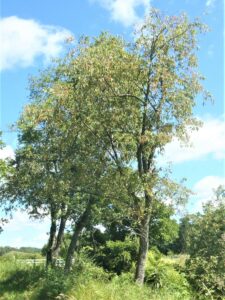
Black Walnut Tree
Fast growing, large tree best on rich fertile soil in the southern half of Wisconsin. Reproduces from stump sprouts and seed. Full sun. Edible nuts produced almost annually, used by humans and wildlife. Excellent tree for valuable high quality lumber. 100+ year lifespan.

Black Walnut Tree
Bur Oak Tree
Medium to large tree. Commonly grows up to 60-80 feet in height and 2-3 feet in diameter. Some trees reach 5 feet in diameter. Slow growing. They will grow on dry upland sites as well as moist ‘bottoms’. Most wide spread of the oaks. They are often seen in pure stands on old pasture sites. A member of the white oak group, it is used to make whiskey barrels, railroad ties, flooring, and furniture. Bur Oaks tolerate alkaline soils. They should be included in any planting.
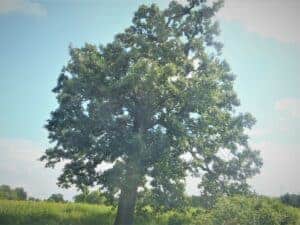
Bur Oak Tree
Domestic Apple Tree
The Domestic Apple has excellent wildlife value, as many types of birds and mammals love to consume apples. In the spring, fragrant apple blossoms will please local bee populations as they collect nectar and pollen. The insects attracted to the trees will surely bring in a variety of birds. In the fall and winter, deer and other mammals will certainly appreciate the much needed food source.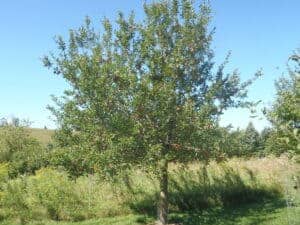
Norway Spruce Tree
A conifer that can reach 125 feet tall and spread to 25-30 feet. They grow well in sandy, acidic, well drained soils. They prefer sunny locations. Fast growing when young and slows with age. The seed is eaten by a variety of woodpeckers, pheasant, and many other varieties of birds. They are commonly plated for Christmas trees.

Norway Spruce Tree
Red Oak Tree
Medium to large-sized tree growing 70-90 feet tall and 2-4 feet in diameter. Red Oak grows best on moist sites with black oak and walnut. They are one of the fastest growing oaks. Wood is most desirable of all red oaks and supplies the majority of all red oak lumber. Red Oak self-prunes very well as large clear stems bringing added.
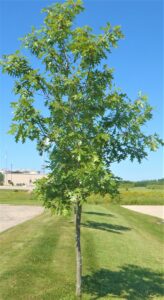
Red Oak Tree
Shagbark Hickory Tree
Large slow growing tree may reach up to 100’ in height. They grow in moist soils. It was often found in association with other hardwood trees. Nuts from the hickory are edible and are often eaten by wildlife such as; squirrels, ducks, pheasants, turkey, and deer. It has dense hard wood used for baseball bats, furniture, and flooring.
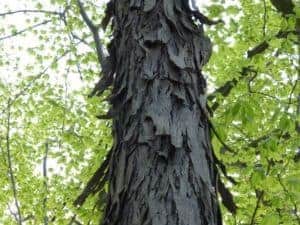
Shagbark Hickory Tree
Sugar Maple Tree
This shade tree grows to be 60-75′ in height with a spread of about 40-50′ at full maturity. It grows in deep, well drained, acidic, to slightly alkaline soil. Prefers moist soil conditions but has moderate drought resistance. This maple has an oval, rounded shape with leaves that are 3-5 in. across with 5, or rarely 3, distinctive lobes. Flower colors are green and yellow and they bloom in April and May. Do not plant in confined areas or where salt is a problem. The wood of the Sugar Maple tree has always been highly valued for furniture because of its beauty and extreme hardness. Once mature enough it can be tapped to make maple sugar.
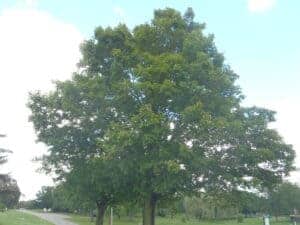
Sugar Maples Tree
Swamp White Oak Tree
Medium-sized tree reaching 50-70 feet tall and 2-3 feet in diameter. Tolerates high moisture, though not long periods of standing water. One of the faster growing species in the white oak group. Wood is used for lumber and veneer. Acorns eaten by a variety of wildlife species.
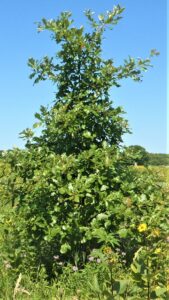
Swamp White Oak Tree
White Oak Tree
Large tree reaching 80-100 feet tall and 2-3 feet in diameter. They grow well on dry uplands and hillsides. Slow growing. Wood is historically the most valued of all the oaks. Early ships were built almost entirely of white oak. Currently used for whiskey barrels, flooring, furniture and veneer. White Oak are becoming more rare in natural stands. They should be planted in any upland planting.
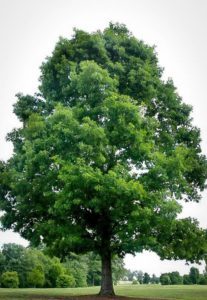
White Oak Tree
White Pine Tree
A conifer reaching 75 to 100′ tall by 30-50′ wide. It can reach well over 100′ tall. They like moist, sandy soils, but grow well on a variety of soil types. They tend to grow in clay soils better than most pines. White pines prefer well-drained soil and cool, humid climates, but also grow in boggy areas and rocky highlands. The needles are in fascicles (bundles) of five (rarely 3 or 4), with a deciduous sheath. They are flexible, bluish-green, finely serrated, and 2–5 in long. Seed is eaten by squirrels, wood duck, bobwhite, pheasant, and many varieties of woodpeckers. The seed and needles are eaten by spruce grouse and turkey.

White Pine Tree
American Hazelnut Shrub
American Hazelnut, Corylus americana, is an easy-to-grow native shrub that produces edible nuts in late summer. Able to thrive in a wide range of conditions, this native shrub is a good choice for hedgerow or windbreak. It can be pruned at any time of year and its deep green leaves turn copper and yellow in autumn. Highly attractive to wildlife, the nuts are eaten by squirrels, foxes, deer, northern bobwhite, ruffed grouse, turkey, woodpeckers and pheasants. The leaves, twigs, and catkins are browsed by rabbits and deer. The male catkins are a winter food for turkey and ruffed grouse.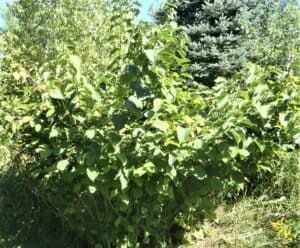
Black Currant Shrub
A shrub that grows 1.5-5’ in height. It prefers moist to wet slightly acidic soil. It favors understory shad but, will grow in sun. Pollinators such as, honeybees, bumblebees, and butterflies are attracted to the flowers in spring. The berries are black in color a 1/3 inch in diameter. Both mammals and birds eat the berries. Berries can also be used to make jelly, wine or pie. Some teas are made with berries. It can be a host for White Pine Blister Rust. We do not recommend planting within 200 feet of White Pine.
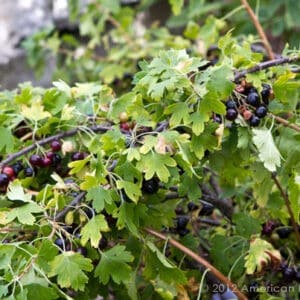
Black Currant Shrub
Ninebark Shrub
It gets its name because its exfoliating bark peels off in papery strips revealing layers of reddish to light brown inner bark resembling “9’s”. Flowers are white in spring and give way to reddish brown fruit. The primary wildlife value of Ninebark is its multi-stemmed arching branches providing cover to small mammals and nesting birds. It grows to a height of 6-10ft. It prefers mesic areas and is drought tolerant.

Ninebark Shrub
Redosier Dogwood Shrub
The Redosier Dogwood Shrub is a shrub native to Minnesota with colorful red or yellow winter bark that provides great winter interest. As a landscape plant, redosier dogwood is extremely versatile. It can be used as an accent, specimen or key plant, and in groups and large masses for borders and screens. Redosier dogwood is also used in plantings for wildlife as its berries attract and are eaten by birds and mammals.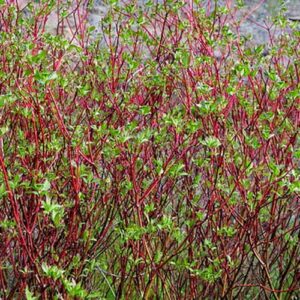
Nannyberry Shrub
A versatile native shrub with excellent year-round interest, Nannyberry Viburnum features showy white flowers in May and burgundy leaf color in autumn with dark blue berries. A large upright shrub, it spreads by roots to form colonies and makes an excellent privacy screen or hedgerow.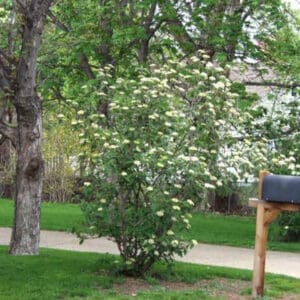
Serviceberry Shrub
A shrub also referred to Juneberry and Shadberry. They prefer moist to well drained soils but, are tolerant to a variety of soils. Reaches a height between 10-20 feet. This shrub is known for its delicate white flowers and delicious fruit. They bear fruit in late June making them the earliest summer berries. Berries attract and are eaten by; Baltimore Orioles, Cardinals, and Scarlet Tanagers to name a few. Deer and rabbits browse on the leaves and twigs. The blue/black fruit tastes and can be used much like blueberries.
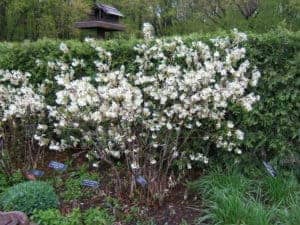
Serviceberry Shrub
Supplies
| 3oz Endo/Ecto Mycorrhizal Root Dip Keeps roots from drying while in the field and stimulates root growth. 3oz package covers about 40 tree/shrub roots. (3oz makes 1gal). 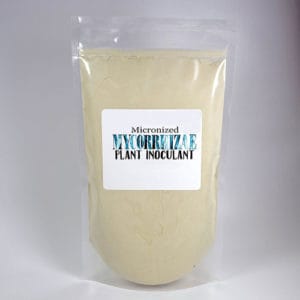 |
Nutrient Packs
|
5’ Tree Tube w/ stake No longer offered by LWCD but contact us for help finding other sellers.
|
Equipment Rental
- Tree Spuds
- Portable Scales
- Backpack Sprayer
- Water Tape
- Soil Probes & Soil Sample Bags.

